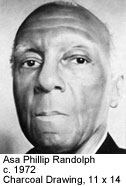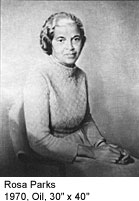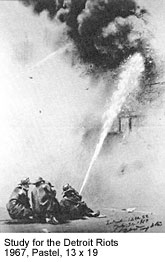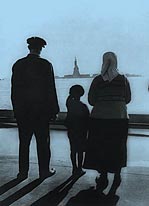Out of a Clear Blue Sky
Documentary Photographic Images: New York, September 11
|
|
9/11 Exhibit Home| | Museum Home PageEssay dated January 10, 2002, by James Stephenson of Bridgeport, junior at Central High School
|
From Connecticut Public Act No. 02-126The Governor shall proclaim September eleventh of each year as [911 Day, which day shall increase the public's awareness of the emergency telephone number and shall be observed in the schools and in other ways as indicated in such proclamation or letter] Remembrance Day, in memory of those who lost their lives or suffered injuries in the terrorist attacks on September 11, 2001, and in honor of the service, sacrifice and contributions of the firefighters, police officers and other personnel who responded to such attacks. Suitable exercises shall be held in the State Capitol and elsewhere as the Governor designates for the observance of the day. Approved June 7, 2002 and signed by Governor John G. Rowland |
Out of a Clear Blue Sky
Documentary Photographic Images: New York, September 11
|
Out of a Clear Blue Sky
Documentary Photographic Images: New York, September 11
|
|
|||||||||||||||
|
|||||||||||||||
Back to WEIR FARM: VISITING ARTISTS 2001 Exhibit Info
Weir Farm National Historic Site and the
|
Weir Farm Visiting Artists ProgramDrawing inspiration from its magical landscape, artists have lived and worked at Weir Farm for 120 years. Underlying the significance of Weir Farm National Historic Site is the preservation of an extraordinary facet of America’s artistic heritage. Equally important, is the preservation of an environment where contemporary artists can thrive. This environment includes not only the physical landscape, but also an atmosphere in which the creative spirit is both fostered and nurtured. Providing outstanding opportunities for promising artists within the context of this environment is a mandate of the Weir Farm Trust and is critical to the success of the long-range management plan of the Farm. The Visual Artists Program including both resident and visiting artists is the cornerstone of the Trust’s programs for professional artists and is central to its mission. The Visiting Artists component was originally envisioned as the first step towards the development of the residency program. Artists apply to the program in all visual art forms and are selected primarily on the quality of their work through a competitive panel process. These artists have reached a level of maturity in their work and have thoughtfully considered why they would like to work at the Farm. Using Weir Farm as an open air studio, participating artists work over the course of a year to create a cohesive body of work influenced by his or her own experiences of the Farm’s cultural and natural resources. Since its beginning in 1991, the program has attracted Guggenheim, Fullbright, National Endowment of the Arts Fellows and Connecticut Commission on the Arts grant recipients, as well as winners of other national and international residency and fellowship awards. We are very pleased with this year's outstanding visiting artists Richard Lang Chandler, Maureen Cummins, Steven Dolbin, Camille Eskell, Thomas Mezzanotte and Michael Torlen. After the conclusion of the work period and as a key benefit of the program, each group of visiting artists is presented in a museum exhibition. We extend our deepest thanks to The Housatonic Museum of Art and to Robbin Zella, Director, for presenting this exhibition of the 2001 Weir Farm Visiting Artists. J. Alden Weir had a lifelong commitment to nurturing other artists. His spirit is alive and well at the Farm, due in great part to the artists who come to immerse themselves in their work, having been captured by the landscape that continues to inspire. Constance Evans |
Back to LEST WE FORGET IMAGES OF THE BLACK CIVIL RIGHTS MOVEMENT 2002 Exhibit Info
Foreward by the Director of HMA
|
FOREWORDBY ROBBIN ZELLA, Director, Housatonic Museum of Art |
 |
|
Terrorism. Unspeakable acts. Unthinkable events. These words explain recent events in New York and Washington, D.C. but less than 40 years ago, these same words could have been used to describe a tumultuous period in American history marked by murders, bombings, and riots. "The Sixties" was a time of immense political and social upheaval in this country - the struggle for Civil Rights, the Days of Rage, the anti-Vietnam War movement, the Women's Liberation movement and Gay Rights movement, and the emergence of a counterculture were periodically punctuated by assassinations: John F. Kennedy, Robert Kennedy, Medgar Evers, Malcolm X and Dr. Martin Luther King, Jr. Artist Robert Templeton witnessed the race riots in Detroit, the illustration of which appeared on the August 4, 1967 cover of Time magazine. Deeply disturbed by this event, Templeton resolved to create a pictorial civil rights history to commemorate its leaders for future generations. Lest We Forget: Images of the Black Civil Rights Movement is comprised of 34 portraits completed over the course of twenty years by this nationally known portraitist and includes key figures such as Dr. Martin Luther King, Jr., W.E.B. DuBois, Ralph Abernathy, Roy Wilkins, and Rosa Parks. But while Templeton focused his energy creating these timeless portraits, photographers such as Gordon Parks, Charles Moore and James Karales captured candid shots from the front lines of the movement. Searing images of police dogs attacking demonstrators, firemen hosing down protesters, King being arrested, and the march from Selma to Montgomery, distributed in newspapers around the country as well as in photo-essays in Look and Life magazines, served to speed the cause of civil rights. Reverend George Lee, Lamar Smith, Emmett Till, Willie Edwards, Jr., Louis Allen, Cpl. Ducksworth, Jr., and Viola Gregg Liuzzo are the ordinary heroes - black and white - memorialized in the film A Time For Justice. Produced by three-time Academy Award-winner Charles Guggenheim, this film is a moving account of the crises in Montgomery, Little Rock, Birmingham and Selma and is an homage to those who gave their lives for the cause of freedom and equality. Although the civil rights movement ended legal apartheid in this country and wrought significant changes in American life for African-Americans, women and other marginalized groups, it is nevertheless true that inequalities and racism remain, and so the struggle continues. I would like to thank the following people for their contributions to this exhibit: Leonore and Kevin Templeton for the loan of Robert Templeton's work; Parker Stephenson, Howard Greenberg Gallery, New York for assisting with the selection and loan of photographs, and Instructor Tony Ball for his comprehensive catalog essay. In addition, special thanks to Shelley Solomon, Assistant Principal at Hall High School in West Hartford and Professor Peter Ulisse for their contributions to educational programming; and to the Southern Poverty Law Center, the Parrish Art Museum, Southhampton, NY; and Bobs M. Tusa, Librarian, University of Southern Mississippi for assistance with research; Dr. James Mooney for educational panels, Helen Barnett for public relations and Blaine Kruger for design. Robbin Zella, Director, Housatonic Museum of Art Return to LEST WE FORGET exhibit home
|
|
Back to LEST WE FORGET IMAGES OF THE BLACK CIVIL RIGHTS MOVEMENT 2002 Exhibit Info
THE PROMISE OF EQUALITY AND JUSTICE FOR ALL
by Tony Ball, Instructor of History
THE PROMISE OF EQUALITY AND JUSTICE FOR ALLby Tony Ball, Instructor of History On August 25, 1864, over a year and half after the issuance of the Emancipation Proclamation, a black woman named Annie Davis wrote President Abraham Lincoln from Maryland. Her words remain poignant to this day:
There is no record of a response from the Lincoln Administration. Of course Annie Davis was not free; the Emancipation Proclamation explicitly excluded those slaves that were in Union-controlled territories, or in slave states like Maryland that had not joined the Confederacy. As Lincoln had famously noted during the Gettysburg Address, the American War for Independence had commenced some "four score and seven" years earlier. But the American Revolution, the long and sometimes violent struggle to make the vaulted principles of the Declaration of Independence a reality for African-Americans and other dispossessed peoples, was only just beginning. In 1865, the 13th Amendment to the Constitution prohibited slavery in the United States. The 14th Amendment defined American citizenship based on birth (not race), and guaranteed to all persons equal protection and due process of law. The 15th Amendment forbade states from denying citizens the right to vote based on their race, color, or previous condition of servitude. With these Civil War Amendments and Congress' Reconstruction program, there was, for the first time in our history, a chance to bring about a more racially just society. Less than a decade after the United States Supreme Court had declared that no African-American could ever be considered a citizen of the United States, the first blacks were elected to the Congress, as well as to the legislatures of the several southern states. Like emancipation for Annie Davis, true progress towards racial justice was elusive. For one thing, most white Americans in the 19th century simply did not believe in equality and were committed to maintaining political, economic and social control over African-Americans. In 1877, Congress officially ended Reconstruction, ordering the withdrawal of the remaining federal troops from the south. Southern whites were free to turn back the clock on equality and reverse those gains that had been made by African-Americans in the years immediately after the Civil War. Black voters were disenfranchised and the legal, economic and social system refined to keep blacks in virtual, if not actual, bondage. Jim Crow laws, mandating the physical separation of the races, were vigorously enforced, and those African-Americans who sought to leave the South for America's Midwest and West often had to do so under cover of darkness. Thousands of African-Americans like Annie Davis were only half-free,
completely subjugated and segregated in a society in which privilege
and skin color were inextricable. It would take two world wars
and an economic depression to bring the nation forward, and to
hold Americans to the ideals of liberty and equality that form
the foundation of our republic. In 1910, the noted African-American sociol- ogist W. E. B. DuBois, the anti-lynching crusader Ida B. Wells, educational pioneer John Dewey, and other progressives helped form the National Association for the Advancement of Colored People (NAACP). Although just two decades earlier the United States Supreme Court had declared in the case of Plessy v. Ferguson that the forced segregation of blacks was constitutional as long as they were given "equal" facilities, the NAACP was committed to the strategy of using litigation to widen opportunities and address racial injustice. Early victories before the Supreme Court in the late 1910s and 1920s suggested that the NAACP had embarked on the right course. Meanwhile, African-American soldiers had served with distinction during America's involvement in World War I (1917-1918), and returned to the United States with greater expectations for equal treatment and economic opportunity. However, the broader society was still ill-prepared for meaningful advances in civil rights. Indeed, after the production of the notoriously racist film The Birth of a Nation in 1915, organizations like the Ku Klux Klan experienced a resurgence, and African-Americans were increasingly the victims of lynching and other forms of racial violence. Indeed, even as black intellectuals and artists thrived during the years of the Harlem Renaissance and as African-Americans migrated to Northern industrial cities from the South in greater numbers, racial violence and injustice became even more entrenched. The American stock market crash in October, 1929, and the ensuing Great Depression devastated African-Americans, who were disproportionately employed in the hard-hit agricultural sector of the economy. However, the Depression also helped forge a political realignment in the United States in which African-Americans, long faithful to Lincoln's Republican Party, were now part of Franklin Delano Roosevelt's Democratic New Deal Coalition. Together with intellectuals, Catholics, Jews, poor farmers and organized labor, African-Americans were part of a new progressivism in the United States which would redefine American society and government's role within it. Despite the importance of African-Americans to Roosevelt's political coalition, little actual progress was made in the area of civil rights during the 1930s. Roosevelt steadfastly declined to endorse federal anti-lynching laws, and much of the legislation aimed at alleviating the effects of the Depression excluded African-Americans. When the United States' entry into World War II seemed an inevitability, the African-American labor leader A. Philip Randolph threatened a demonstration in the nation's capital to protest unjust treatment at home. Roosevelt responded by issuing an executive order which forbade government contractors from discriminating in hiring or wages based on race, and Randolph called off the march on Washington. As they had in World War I, African-American soldiers, sailors and airmen played a crucial role in the second World War, although again in segre-gated units. Significantly, blacks and women were vital to the nation's wartime industries which produced the munitions, planes, ships, tanks and other equipment necessary in the prosecution of the war. World War II forced Americans to look more carefully at their own record on race and civil rights and further raised the expectations of African-Americans. In 1946, Franklin Roosevelt's successor Harry Truman created the Federal Committee on Civil Rights; two years later Truman ordered the desegregation of the U.S. armed services. Meanwhile the NAACP continued its litigation strategy. When a black student at the University of Oklahoma was not allowed to sit in the same classroom with white students, the NAACP filed suit. The Supreme Court invalidated the University of Oklahoma's segregation policy, ruling that forcing the student, G. W. McLaurin, to sit in an adjoining hallway could not be considered equal treatment as required by the 14th Amendment or the Supreme Court's 1896 Plessy v. Ferguson decision. At the same time, the Court indicated its willingness to reconsider Plessy's "separate but equal" doctrine altogether, and NAACP attorneys began to envision an end to legally enforced Jim Crow segregation. That opportunity came with the 1954 case of Brown v. Board of Education of Topeka, Kansas in which Chief Justice Earl Warren declared on behalf of a unanimous court that the segregation of children in public schools solely on the basis of race violated the Constitution's 14th Amendment, because "separate educational facilities are inherently unequal." This ruling was a major victory for the NAACP and for Thurgood Marshall, who argued the case before the Court and would subsequently be named the nation's first African-American Supreme Court justice. However, getting southern states to adhere to the Court's mandate would be no easy task and after the Brown decision the civil rights strategy clearly shifted from litigation to political activism and protest. White resistance to desegregation was fierce. In the summer of
1955, a 14-year-old boy named Emmett Till was lynched in the small
town of Money, Mississippi, presumably for having said "bye, baby"
to a white woman in a candy store. Throughout 1955, local sheriffs
in the South stepped up the enforcement of Jim Crow laws and customs,
notwithstanding the clear direction of the Supreme Court towards
invalidating such segregation. In Montgomery, Alabama, a 15-year-old girl black named Claudette Colvin was arrested for refusing to give her bus seat over to a white passenger. Montgomery's civil rights community considered rallying to Colvin's cause but ultimately decided that Colvin, who was unmarried and pregnant at the time, might not be the best person to symbolize the pernicious effects of Jim Crow segregation. Some months later, in December of 1955, a 43-year-old seamstress named Rosa Parks was arrested by Montgomery's police also for having refused to vacate her bus seat to a white passenger. This time, the civil rights community in Montgomery mobilized, forming a Montgomery Improvement Association (MIA) and calling for a boycott of the city's public transportation system. The MIA selected as its president a young minister named Martin Luther King, Jr. and the modern civil rights era had begun. The Montgomery Bus Boycott lasted over a year. Although the practice of boycott in America went back to the days preceding the War for Independence, King and the entire MIA leadership were indicted on charges of "conspiring" to disrupt the city's bus system. Bayard Rustin, one of King's closest advisors, urged the Montgomery boycott organizers to submit freely to arrest following the non- violent principles of Mohandas Gandhi. The adoption of passive resistance, and King's subsequent articulation of principles of non-violence based on Christian theology, elevated King as a moral leader and gave him national stature. The boycott finally came to an end on December 21, 1956, after the U.S. Supreme Court declared Montgomery's bus segregation unconstitutional. But King was committed to taking the civil rights agenda forward. He helped form a new organization, the Southern Christian Leadership Council (SCLC), whose focus extended beyond desegregation of transportation facilities to education, voting rights, employment and economic opportunities. President Dwight D. Eisenhower had succeeded Harry Truman in 1953. Eisenhower gave only lukewarm support to the Supreme Court's decision in Brown v. Board of Education. However, he did back the Civil Rights Act of 1957, the first federal anti-discrimination legislation since the end of Reconstruction. In 1957 Eisenhower also sent 1,100 federal troops to Little Rock, Arkansas, to enforce a federal court order mandating the admission of black students to the city's Central High School. In the early the 1960s, young people began to take a more active
role in the growing civil rights movement. Black college students
developed the strategy of the sit-in, aimed initially at forcing
the desegregation of local restaurants in places like Greensboro,
North Carolina. Student activism represented a new phase in the
civil rights movement as well as the beginning of the political,
cultural and social turmoil of the 1960s. In April, 1960 young
people met and formed the Student Nonviolent Coordinating Committee
(SNCC). SNCC initially embraced nonviolent strategies but during
the 1960s its use of direct confrontation and increasing militancy
would stand it in sharper contrast with King and the older, more
conservative civil rights leaders. In 1961, college students began partici-pating in "Freedom Rides" in which interracial groups challenged segregation aboard interstate buses and trains. When John Lewis, one of the black riders and a future member of Congress, entered a Greyhound station in Rock Hill, South Carolina, he was brutally attacked by a white mob. The local police stood by and watched. That incident and subsequent violence against freedom riders highlighted the need for strong federal leadership. King and other civil rights leaders appealed to President John F. Kennedy for support. But Kennedy was hamstrung by his own party; southern Democrats constituted a powerful bloc in the Senate and were committed to defeating any additional civil rights legislation. That reality led the NAACP, SNCC, the SCLC and the Congress on Racial Equality (CORE) to focus their efforts on voter registration and education in the South. Despite their differences, all of the major civil rights groups began to view political empowerment as a necessary precondition to further progress. But political enfranchisement struck at the heart of the white power structure, and led to escalating levels of violence and suppression against civil rights activists. Alabama's state courts prohibited protest, and in April, 1963, King was arrested in Birmingham for engaging in a nonviolent march. From his Birmingham jail cell, King wrote a famous letter which crystallized his philosophy and energized the civil rights movement. Freedom, wrote King, "is never voluntarily given by the oppressor; it must be demanded by the oppressed." The goal of nonviolent direct action was "to create such a crisis and foster such a tension that a community... is forced to confront the issue." That crisis had certainly arrived in 1963. In May much of the nation and indeed the world was outraged when Birmingham's police chief, Eugene "Bull" Connor, set his fire hoses and police dogs on young children, assembled to peacefully protest continued segregation and injustice in the city. This, and the assassination of civil rights leader Medgar Evers in Jackson, Mississippi, the following month illustrated the point that white segregationists were willing to use terror and violence to stem the tide of change. In response to the violent turn of events, the Kennedy administration proposed more sweeping civil rights legislation, but again this effort was stymied by southern Democrats. A coalition of civil rights organizations sought to support Kennedy's initiatives by planning a new protest on Washington, 22 years after A. Philip Randolph's threatened protest in the nation's capital had been called off. In August, 1963, over a quarter million marchers gathered before the Lincoln Memorial to hear King's dream for a racially just society, in which people would be judged not "by the color of their skin but by the content of their character." King's impassioned plea did not stop the racial violence. Just two weeks later four little girls attending Sunday school in Birmingham were killed when a bomb planted by white racists exploded at the 16th Street Baptist Church. After John F. Kennedy's assassination in November, 1963, the civil rights movement took a new turn. Kennedy's successor, Lyndon Baines Johnson, was committed to the civil rights agenda. Moreover, as a former southern senator himself, Johnson had the standing and political skill to effectively deal with the members of his own party who had stymied legislation in the past. Johnson engineered Congressional passage of the Civil Rights Act of 1964, made all segregation in public facilities illegal, established an Equal Opportunity Employment Commission to combat job discrimination, and banned gender discrimination in employment and education. As Congress was taking up the civil rights legislation, activists continued their voter registration and education efforts. The major civil rights organizations targeted Mississippi for a massive voter registration drive to begin in the summer of 1964. Mississippi's "Freedom Summer" attracted scores of college students from throughout the nation who braved racist local law enforcement, the Ku Klux Klan and the hostilities of white mobs to enfranchise African-American voters. The murder of three student activists - James Chaney, Andrew Goodman, and Michael Schwerner - in June and a wave of church bombings, shootings and beatings, did not prevent the organizers of the "Freedom Summer" from empowering hundreds of black voters. However, the violence perpetrated against the Freedom Summer activists, as well as the escalation of the conflict in Vietnam, persuaded many young people in the civil rights struggle that the time had come to abandon the core principles of nonviolence and passive resistance that King had popularized. Moreover, the traditional civil rights focus on desegregation seemed to ignore many of the pressing social and economic problems faced by African-Americans outside the south. The once booming industry that had attracted blacks to the northeast and midwest were beginning to close, and America's central cities had fallen into a rapid decline. The black nationalist and Nation of Islam spokesman Malcolm X came to stand for a more militant urban movement, which questioned the wisdom of nonviolence as well as the emphasis on integration. Malcolm X's assassination in 1965 did little to quiet this more strident activism. In 1966, Stokely Carmichael became chair of SNCC. He moved to expel SNCC's white members and to promote more militant confrontation. Even the word "Nonviolent" in SNCC's acronym was changed to "National," clearly indicating the new direction the organization was taking. "Black Power" became Carmichael's favorite slogan. H. Rap Brown, Carmichael's successor at SNCC, declared violence "as American as apple pie." In October, 1966, Huey Newton and Bobby Seale founded the Black Panther Party for Self-Defense in Oakland, California. The Party's minister of education, Eldridge Cleaver, became one of the nation's most eloquent and controversial spokesmen for the new militancy which advocated the violent overthrow of repressive political and economic systems. Part of the problem was that after the passage of the Civil Rights Act of 1964 and the subsequent 1965 Voting Rights Act, the goals and objectives of the civil rights movement became much less clear. King began to speak more clearly about issues of poverty and oppression that transcended racism, launching plans to begin a Poor People's Campaign in 1967. He also spoke out against the war in Vietnam. But the issues of poverty and American policy abroad were far more complex than dismantling Jim Crow segregation in the south, and their solutions far more elusive. To many, King's assassination in 1968 marked the end of the traditional civil rights movement. SNCC was virtually defunct by 1969 and most of the Black Panther leadership was either jailed, exiled or dead by the end of the decade. There can be little doubt that America still has a long road before (to quote King's "I Have a Dream" speech) the nation rises "up and lives out the true meaning of its creed." But the changes which occurred in American society during the late 1950s and 1960s were indeed profound, and moved the nation far closer than it has ever been to fulfilling the constitutional promise of equality and justice for all. Tony Ball |
Back to FREEDOM: A History of US Educational Support Materials
Back to FREEDOM: A History of US Exhibit Info
Educational Support Materials for the exhibit...
|
|
|
WEB SITESwww.firstamendmentcenter.org - annual report on survey of public views on the First Amendment VIDEOTAPES, CDs and MOVIES
BOOKS
Educational Materials Prepared by Janet Luongo, Educational Consultant |
|
Back to FREEDOM: A History of US Exhibit Info
Educational Support Materials for the exhibit...
|
|
|
Back to FREEDOM: A History of US Educational Support Materials
Back to FREEDOM: A History of US Exhibit Info
Educational Support Materials for the exhibit...
|
|
|
THE EXHIBIT: FREEDOM: THE HISTORY OF USThe current exhibit is Freedom: The History of US, sponsored by G.E. In a letter informing schools about the exhibit, Gus Serra, Manager of Community Relations and Communication at G.E., wrote:
The exhibit is based on the book, Freedom: A History of US by Joy Hakim, and was made into a landmark series of 16 TV documentaries that aired on PBS for eight weeks beginning in January, 2003. The videos are available from PBS and study guides and activities are available at www.pbs.org. When students come for the Freedom Tour, they may see excerpts from the PBS series. The following is from the introduction to the PBS guide:
There couldn’t be a better time for you to see this exhibit, because the issues it covers are very alive at this moment in our nation as issues of democracy and our constitutional freedoms are being hotly debated in Congress and all across the United States. The exhibit reproduces revolutionary documents – primary sources - of our history that proclaimed our rights to self-government and freedom. It shows evidence – letters, photographs, art work - of the work of courageous men and women who took great risks as concepts of freedom evolved. As preparation for the exhibit and, as a follow-up, we encourage your students to conduct research and engage in discussions and debate on their views about the past and present state of our freedoms. This is not a mere academic exercise, but the results of the research and the actions taken can affect the students and the future history of our great country. GOALS OF THE FREEDOM TOURAfter viewing the exhibit and participating in dialogue, students will:
The exhibit was developed by Gilder Lehrman Institute of American History and the Meserve-Kunhardt Collection and is presented by PictureHistoryEducational Materials Prepared by Janet Luongo, Educational Consultant |
|
Back to FREEDOM: A History of US Educational Support Materials
Back to FREEDOM: A History of US Exhibit Info
Educational Support Materials for the exhibit...
|
|
|
SUGGESTED HIGHLIGHTS – FREEDOM TOURTours are interactive; students who are currently studying American history are asked to contribute what they know about the periods or events depicted. Students are asked to comment on what they see, think and feel about the reproductions of visuals and documents. The tour begins with the colonial period and ends with the twentieth century, but most of the panels are on the 19th century and the Civil War. Trained guides will start with a basic review of the founding principles of freedom. They will choose from 8-12 of the following highlights, according to the suggestions of the teachers and the interest of the students.
|
|
More Articles …
- About Grain
- Agent Orange Photos
- Genesis Images
- Grain Images
- Amy Bartell and the Mural Project Images
- Illustrating Connecticut Book
- American Illustration
- Essay by Carol Kino
- Biographies of the Curators of Polaridad Complementaria: Recent Works from Cuba
- Pattern, Power, Chaos and Quiet
- Close To The Line
- Telling Portraits
- Forms Derived from a Cube: Sol LeWitt 1998 1998
- Personal Affects: The Wishbone Project / The Pillow Project 1999
- Producing Histories: African Art in the Housatonic Museum of Art Collection 1999
- THOMAS ROSE 1999
- Edgar and Toby Buonagurio: Opulence Against The Grain 1999
- PRILLA SMITH BRACKET: Remnants: Ancient Forests & City Trees 2000/2001
- BUILDING ON A LEGACY: RECENT GIFTS 1997 - 2000 2000
- JONATHAN TALBOT / COLLAGE PAINTINGS / 1980-2000 2000


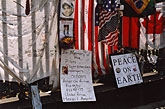

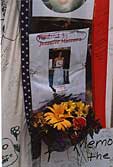
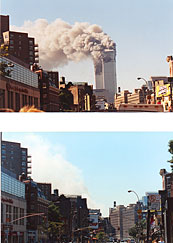

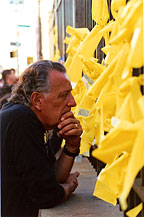
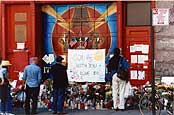
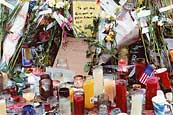



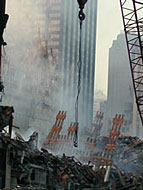
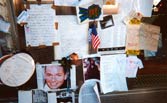
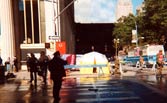

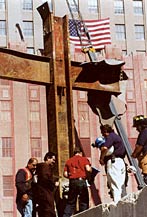
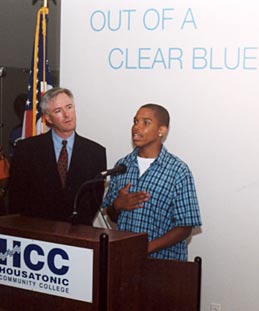
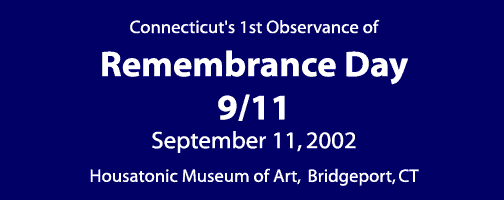


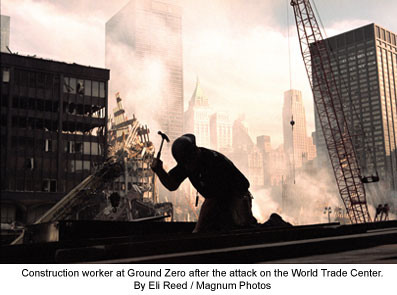
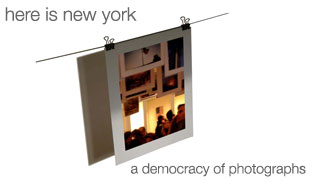 here is new york is not a conventional gallery show. It is something new, a show tailored to the nature of the event, and to the response it has elicited. The exhibition is subtitled "A Democracy of Photographs" because anyone and everyone who has taken pictures relating to the tragedy is invited to bring or ftp their images to the gallery (in SOHO) , where they will be digitally scanned, archivally printed and displayed on the walls alongside the work of top photojournalists and other professional photographers.
here is new york is not a conventional gallery show. It is something new, a show tailored to the nature of the event, and to the response it has elicited. The exhibition is subtitled "A Democracy of Photographs" because anyone and everyone who has taken pictures relating to the tragedy is invited to bring or ftp their images to the gallery (in SOHO) , where they will be digitally scanned, archivally printed and displayed on the walls alongside the work of top photojournalists and other professional photographers. 
